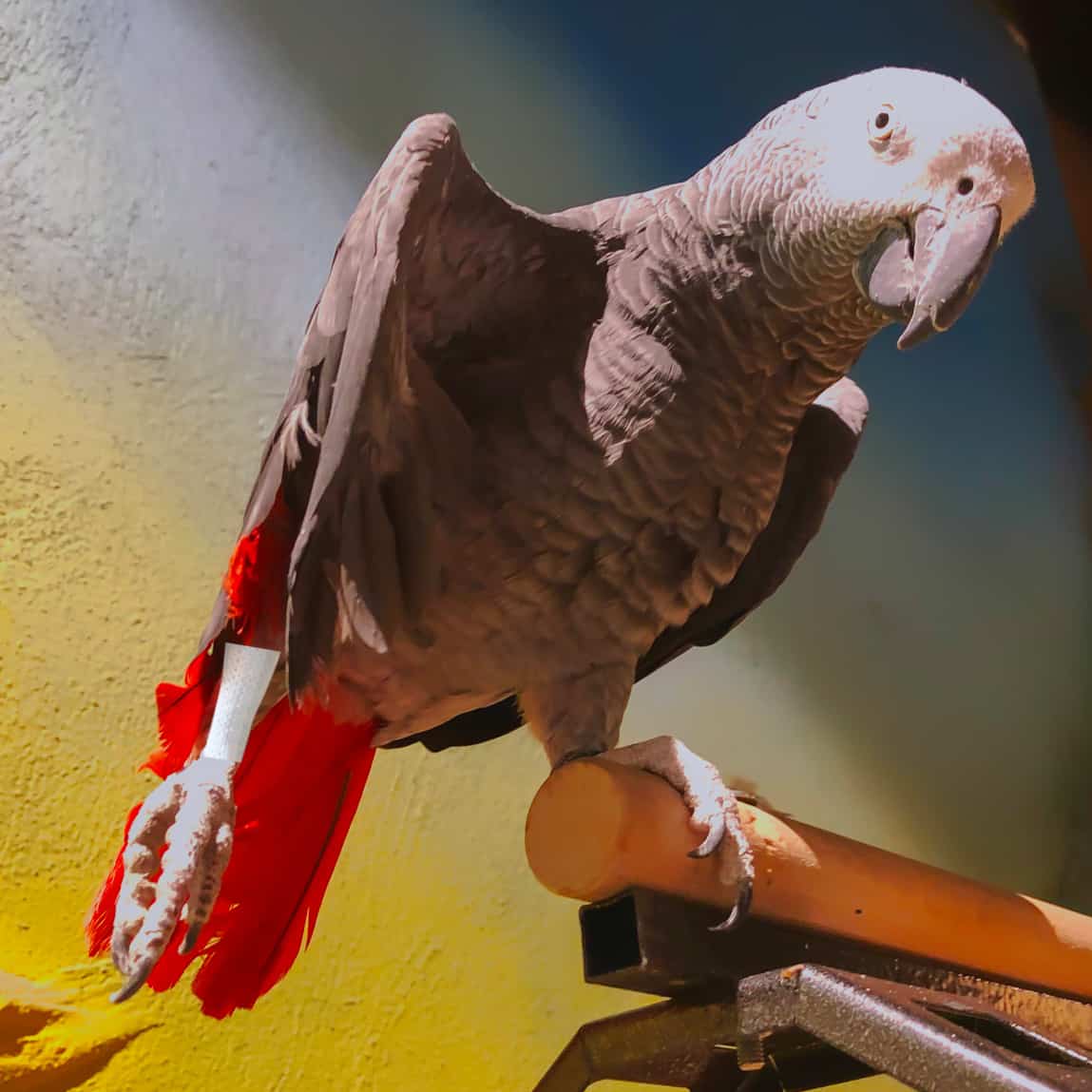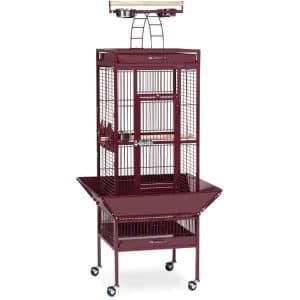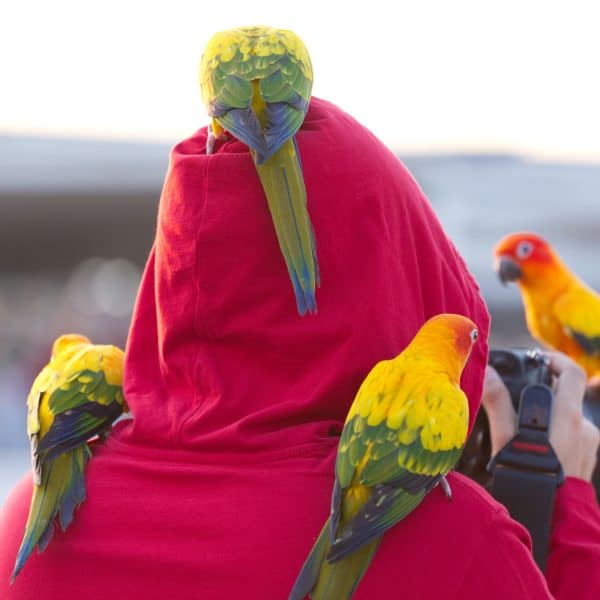
How She Cared For Her African Greys Fractured Leg Bone
Last Updated on by Mitch Rezman
Hi Mitch and Catherine,
Thanks again for an informative ‘Sunday Birdie Brunch’!
I would appreciate some guidance…
Due to my carelessness and haste a month ago, I scooped Hannah up as she was running down the hallway and dropped her by accident.
I saw the look on her face and her holding her leg and knew immediately she was injured.
I took her to the vet the next day and she did have a fractured bone in her left leg.
She is healing well in spite of the fact that she has removed the cast twice from under the bandage unbeknownst to me even though I have kept a close watch on her daily!
She is not allowed in her (lovely big cage I purchased from Windy City Parrot) for 6 more weeks.
Hannah is sleeping in a pussycat crate set up with a soft towel and perch and toys and water and food and she seems to really enjoy it!
She plays in my bathroom sink most of the day chewing toys (see pic).
Where else can I leave her safely during this healing period when she cannot be in her cage?
She is never left alone, someone is always home with her.
Thanks for any creative ideas you have!
Have a ‘grey’t day!
Joanie and Hannah
Hi Joanie,
One of my worries that immediately comes to mind is Hannah becoming broody with the cat carrier offering a (dark) wonderful place to start making babies.
You could probably put her in her big cage but just lower all of the toys and accessories 6 to 12 inches from the floor of the cage as well as the food and water
Make sure that she has lots of horizontal surfaces to perch on because we don’t know if the break has affected her flexor tendons.
You might want to ask your vet about that because the tendons are how she controls her foot and her ability to wrap her foot around a perch
We feel your pain as our (now passed) cockatiel Popcorn suffered a sprained ankle.
She had gained 25% of additional her body weight by accumulating fluids courtesy of Ascites.
Her leg couldn’t handle her precise landings.
best
Mitchr
Joanie S. REplied
Hi Mitch,
Thanks so much for your reply and taking time to help me.
I am so grateful.
Hannah was eggbound in August (she began to get hormonal in 2016 right after our pussycat passed away and I believe they are related), so the cat carrier for sleeping had me worried as you suggested.
So far we are doing okay.
I think the injury has eliminated the cavity seeking behavior for now,
And as my vet, Dr. Vickstrom has suggested I not use the leg fracture method every year to stop cavity seeking!
I have been working with Pamela Clark since Hannah became eggbound.
The new large cage was the first step and Pam had helped me with complete diet change which greatly reduced the cavity seeking behavior immediately.
I thought about the cage as you suggested however even with all her food and toys and perches low she will climb. She is a climber. Hannah is beginning to heal and I am having trouble and exhausted keeping her still!
This is one of her favorite spots. (see photos) I walked out of the kitchen for a moment and came back to find her here on the faucet.
She loves to bath and swing when I run the water and sitting there waiting for me to turn it on. I think not Hannah!
Yes, all horizontal surfaces. There is nerve damage. Not sure how much however there is increasing use of toes and good weight bearing on the leg. It does look like she is gripping now with one of the toes
I know this will take time.
I appreciate your kindness and compassion.
Blessings,
Joanie
PS: thanks for the article….looking forward to reading it!
Rabbit cage – https://windycityparrot.com/carriers-c-232_248/hospital-cage-for-parrots-birds-or-small-animal-home-by-prevue-620-p-5775.html
Wish I could do more
best
mitchr
Hi mitch
Just to update you…
Hannah is sleeping in her wired travel carrier and is out of the (nest) pussycat crate.
We saw Dr. Vickstrom today.
Hannah has good use of the leg and is doing nice gripping with her toes…still not full strength yet.
The plan is to take off the bandage next week, final x-ray and she should be back in her big cage!
By the way, she has taken off the cast every week…bit by bit…and we cannot figure out how she got her beak in there to do that!
In spite of that, she has healed really well and I am grateful.
This was my fault….being in a hurry and ‘insane’ (my term for being willful and affected by someone else’s behavior).
Apparently, I have had many opportunities to learn this lesson and have not gotten it…
So the universe and Hannah really opened my eyes this time and I am going to ‘slow my roll’.
I will send a picture when Hannah is back in her Windy City cage!
Looking forward to the Sunday Birdie Brunch with you both.
Joanie
Hannah today at the vet
New Question from Quora
What are the lowest temperatures for an African grey bird?
If you’re comfortable your bird is comfortable – if you’re cold the bird is cold.
That said it’s not necessary to heat the whole home.
You can warm the bird with thermo perches, panels, and infrared warming bulbs.
We keep oil-filled space heaters next to our cages and thermo perches in the cage.
Temperature is not the only factor. You’ll want to avoid warm air from forced air furnaces and cool air from air conditioners and ceiling fans
For the record average temperatures on the Serengeti where Greys are found a range from the mid-’50s (F) at night and the high 70’s – low 80’s (F) during the day
santiago a. Asks
Can the large Prevue bird ladder for $11.00 be used for an African-Gray parrot?
Alasha
Hi Alasha
Do you mean the Large Rope Ladder from Prevue Pet? If this is what you are inquiring about yes it would be fine for both Timnehs and Congos.
I would advocate cable ties around the hooks where you attach it to the cage to prevent an accident (as seen in the video thumb below)
[videopress yH8hN5QI]
mitchr
Willliam
We have a red-tailed African Grey parrot. Thru the years she is developing more and more red on her back and stomach. Is this common in African Greys?
William, it is hard to say, it depends on how much red factor runs in her DNA – it can get pretty extreme as in this video.
Nutrition and lighting are also factors in feather coloration – please find more info here:
best
mitchr
Author Profile
Latest entries
 The Traveling BirdJune 26, 2025Can You Name 5 Parrot Species That Are Living Wild in the USA?
The Traveling BirdJune 26, 2025Can You Name 5 Parrot Species That Are Living Wild in the USA? Bird BehaviorJune 26, 2025How is it Parrots Are Problem Solvers Social Animals and Even Use Tools?
Bird BehaviorJune 26, 2025How is it Parrots Are Problem Solvers Social Animals and Even Use Tools? Bird & Parrot AnatomyJune 25, 2025How a Tiny Chemical Modification Makes Parrots Nature’s Living Paintings
Bird & Parrot AnatomyJune 25, 2025How a Tiny Chemical Modification Makes Parrots Nature’s Living Paintings PigeonsJune 20, 2025How Do Parrots Thrive in Cities Outside Their Native Habitats?
PigeonsJune 20, 2025How Do Parrots Thrive in Cities Outside Their Native Habitats?


